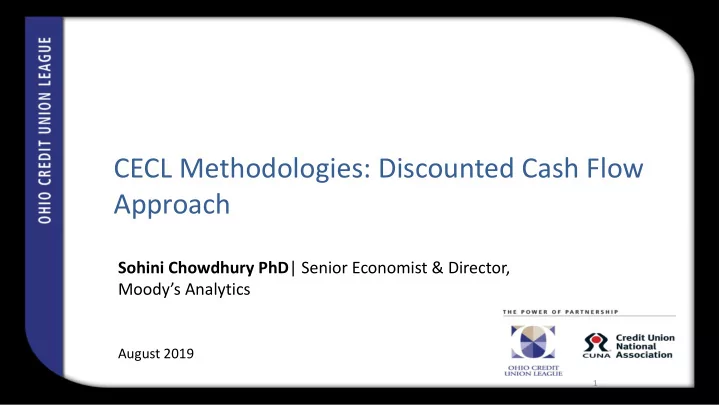

CECL Methodologies: Discounted Cash Flow Approach Sohini Chowdhury PhD | Senior Economist & Director, Moody’s Analytics August 2019 1
DCF in FASB Guidelines § 326-20-30-4 If an entity estimates expected credit losses using methods that project future principal and interest cash flows (that is, a discounted cash flow method), the entity shall discount expected cash flows at the financial asset’s effective interest rate. When a discounted cash flow method is applied, the allowance for credit losses shall reflect the difference between the amortized cost basis and the present value of the expected cash flows
Discounted Cash Flow Approach ❑ CECL reserves = Amortized Cost – Discounted expected value of all future cash flows ❑ DCF models will differ based on how the expected value of future cash flows are calculated ▪ Probabilities of default, prepayment and recovery could be calculated from simple assumptions or from a rigorous model ❑ Not recommended for pool level or portfolio level analysis ❑ Future cash flows to be discounted by the asset’s effective interest rate at the evaluation period (not a forecast of the interest rate)
Future Cash Flows Scheduled or Contractual Cash Flows … Balance(i-1) Principal(i) Interest(i) Balance(i)
Future Cash Flows Scheduled or Contractual Cash Flows … Balance(i-1) Principal(i) Interest(i) Balance(i) f(i-1)*p(i) f(i-1)*d(i) Multipliers f(i-1) f(i) f(i) f(i) Prepay Principal Balance Default Interest Balance … (i-1) Amt(i) (i) (i) Amt(i) (i) Expected Cash Flows LGD(i) 1 – LGD(i) Loss Recovery (i) (i) d(i) = Default probability, p(i) = Prepayment probability, LGD(i) = Loss Given Default, f(i) = Survival probability after period i f(i) = f(i-1) * (1 – p(i) – d(i))
Time to Liquidation in Mortgages by States 6
Timing of Recoveries is Critical in DCF Cumulative probability of liquidation in any month after the default date for a mortgage loan 7
DCF Pros and Cons PROS CONS ▪ Intuitively best aligns with the CECL requirement ▪ Most complex from a data requirements of estimating lifetime losses while considering perspective the timing and prepayment behavior ▪ Requires more instrument-level input parameters ▪ Considers various cash flow schedules, loan (e.g. EIR, prepayment rates, spreads, etc.) than maturity, and diverse array of loan terms such as other methods balloon payments ▪ Best done using a software because of the large ▪ Considers the time value of money for the amount of data it produces. projected losses ▪ Double counts credit risk through recognition of ▪ Can work off contractual life. Don’t need to make credit risk in both the expected cashflow and the assumptions about life of loan discount rate
DCF Double Counts Credit Risk The amendments in this Update were adopted by the affirmative vote of five members of the Financial Accounting Standards Board. Messrs. Kroeker and Smith dissented. Messrs. Kroeker and Smith recognize that – … when performing a present value calculation of future cash flows, it is inappropriate to reflect credit risk in both the expected future cash flows and the discount rate because doing so effectively double counts the reflection of credit risk in that present value calculation . If estimates of future cash flows reflect the risk of nonpayment, then the discount rate should be closer to risk- free. If estimates of future cash flows are based on contractual amounts (and thus do not reflect a nonpayment risk), the discount rate should be higher to reflect assumptions about future defaults. However, when a discounted cash flow method is used, the amendments in this Update require expected cash flows (that is, contractual cash flows that are adjusted for expected defaults) to be discounted at the loan’s original borrowing rate (which by definition reflects assumptions about future defaults).
Where DCF is Most Applicable 1. Where there is a lack of reliable historical data. Industry benchmarks can be used to guide PD, LGD, Prepayment assumptions to generate expected cashflows. 2. Where cashflow timings are irregular. Eg. balloon payments. 3. Where there are individual loans with exotic payment patterns 4. Where the expected life of the loan (diff from contractual life) assumption is not straightforward 5. Where there are TDRs 6. Where there are AFS securities (DCF must be used, as per CECL guidelines)
Other Advantages of DCF The timing-adjusted loan level cash flows produced in DCF has applications beyond CECL ▪ Discounting the future cash flows using different interest rates (eg. cost of funds, ROA, ROE, opportunity cost) produces the NPV for pricing, Exit price etc. ▪ Can be used to estimate profitability of the loan ▪ Can be used in pricing, hedging etc.
DCF Example C&I Term Loan Example Assumptions Formula Loss Allowance = Amortized Cost – Present Value of Expected » Amortized Cost = $986,732 Cash Flows discounted by EIR » Remaining maturity = 5 years » Fixed Coupon Rate = 5% Expected Cash Flows = Amortization +Prepayment +(1-PD* » Amortization type = Linear » EIR = 5.5% LGD) * EAD + Expected Interest » Prepayment = 2.0% » PD1=0.5% ; PD2=0.7%; PD3=0.9%; PD4=1.1%; PD5=1.7%; » LGD1=50%; LGD2=52%; LGD3=54%; LGD4=56%; LGD5=58%
DCF Example C&I Loan Example Principal Expected Expected Total Prepayment Performing Recovery Principal Interest Expected Discounted Period Amount Balance Amount Payment Payment Payment Cash Flows (A) (B) (C) (D) (A+B+C+D) 2018 1,000,000 15,989 2,498 199,001 49,716 267,204 253,283 2019 780,014 11,724 2,626 193,636 38,807 246,792 221,715 2020 569,183 7,584 2,354 188,021 28,184 226,144 192,580 2021 368,459 3,682 1,781 182,205 18,208 205,877 166,187 2022 178,523 0 1,346 175,319 8,760 185,425 141,880 Total 975,646 Loss Allowance = 986,732 – 975,646 = $ 11,087
Recommend
More recommend